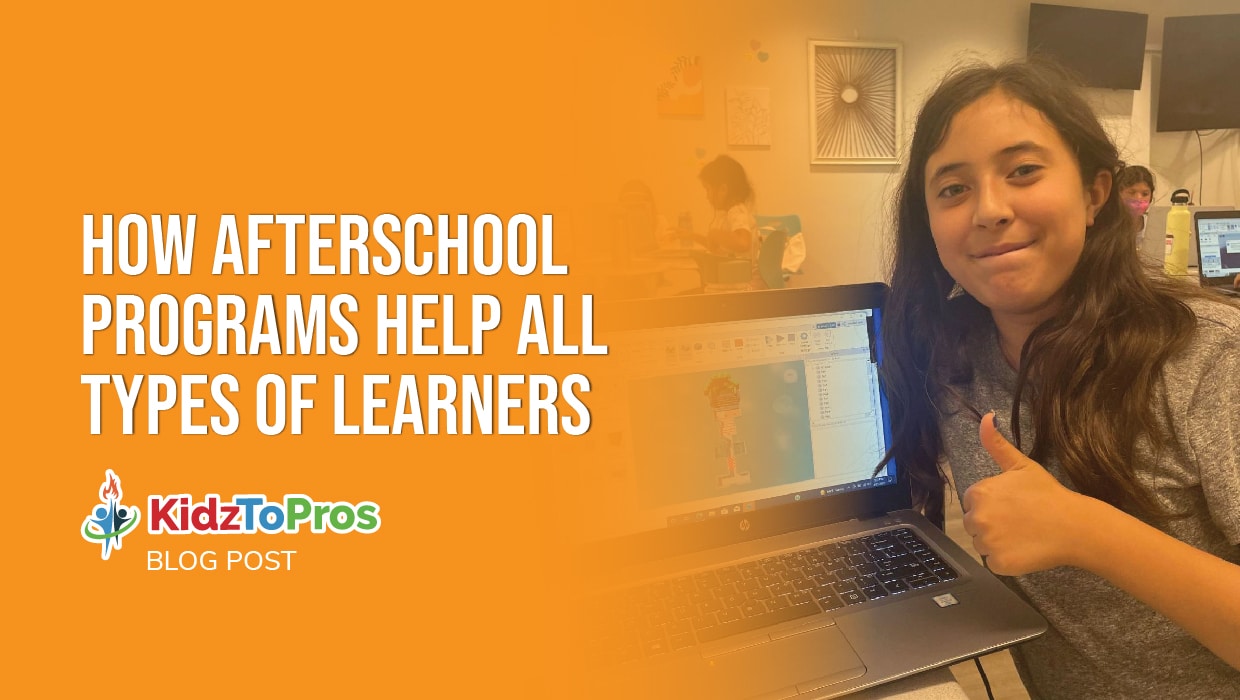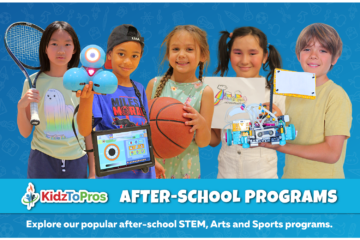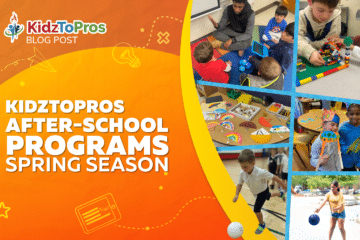How Afterschool Programs Help All Types of Learners

Sometimes, as parents, we wonder if our kids hear anything we say, right? It seems that everything they hear goes in one ear and out the other, as the saying goes. But did you know that children learn in many different ways? Reaching them means figuring out how they communicate, process information and retain it. That’s what the best afterschool programs aim to do: tap into each student’s personal learning style. Then they use learning differences to teach to kids’ strengths, so they learn more effectively.
Whether your child struggles in school, makes straight A’s or deals with learning differences on the daily, afterschool care activities provide an avenue to help. Programs like KidzToPros’ identify and target students’ learning styles and individual learning needs. That helps youngsters achieve a great education!
4 Types of Learners: How the Best Afterschool Programs Reach Them
Sitting in a classroom listening to a teacher lecture isn’t always the best mode of learning. Whether your child is 4, 12 or anywhere in between, they need opportunities to learn in different ways.
That’s why the best afterschool programs like KidzToPros’ combine individual, small group and whole-class learning environments. As kids work alone, with other students and alongside instructors, they listen, watch, move and touch, experiencing new information in multiple ways.
You know your child better than anyone. And you’ve probably observed which of the above activities they enjoy most. Consider that as we present to you the four types of learners. Then schedule afterschool activities that meet your child’s needs and teach them in the way they learn best.
Learner #1: The Visual Learner
Visual learners learn by watching. They see and think in pictures or written words and often close their eyes to visualize or remember things. They are attracted to color, vivid imagery and geometric patterns. Because of this, they usually enjoy watching videos or demonstrations, taking notes with brightly colored pens or pencils, creating and sharing graphs and images, and using graphic organizers to collect and sort information.
When a visual learner watches a project – or, in the case of sports, a game – from beginning to end, they become very observant. They notice the details, see what works and what doesn’t, and make a plan to change what needs changing.
Visual learners may have difficulty with spoken directions and may also become easily distracted.
If your child is a visual learner, consider afterschool options like Art Skills, LEGO Robotics, Minecraft Coding or Play It All Sports to play to their strengths.
Learner #2: The Auditory Learner
Learning by hearing is how auditory learners work. When they hear instructions or listen to stories, vocabulary or test questions read out loud, it triggers understanding and memory.
Auditory learners often multi-task well, appearing not to listen, when actually they hear everything that is said. Students like these often hum or talk to themselves or others when they’re bored, because hearing is everything to them. They’re usually big music lovers, and can recall nearly any information put to music.
Auditory learners are great at carrying on conversations and talking things through. However, they may monopolize the conversation just because they enjoy hearing themselves speak. Repeating instructions verbally to an auditory learner helps them organize their thoughts and carry through with what they need to do.
The best afterschool programs often do a great job engaging auditory learners in programs such as Makerspace, Improv Comedy and Hip-Hop.
Learner #3: The Tactile Learner
Tactile learners learn by touching and experiencing things. As hands-on students, they prefer active learning while taking frequent breaks. They enjoy moving, building and manipulating objects. They love tinkering with things, taking them apart and putting them back together.
These youngsters understand and interpret the world around them through physical movement. They often speak with their hands, gesture with their bodies and have a hard time sitting still. The class doodlers, they tend to draw pictures of what they learn and sometimes tap their pencil on their desk. They may shake their leg rhythmically or hold something in their hands during class because it helps them learn.
Kids like this also communicate by touching, so a pat on the back for a job well done means the world to them.
Tactile learners often do well in afterschool programs such as Creative Arts, LEGO Masters, Wonder Robotics, Soccer and Origami Masters.
Learner #4: The Kinesthetic Learner
Learning takes place for kinesthetic learners when they interact with their environment. These kids achieve understanding through physical activities, rather than by listening to lectures or watching visually presented information. Deep learning occurs as they do by touching or feeling objects.
Kinesthetic learners do well with objects such as models, clay, drawing materials, maps and computer mice in their hands. They often get restless during class and focus better with a stress ball, silly putty or similar object. If the teacher allows, bouncing a ball as they practice language skills or math problems out loud helps cement learning and improve recall.
Since they involve movement using multiple body parts, these learners often enjoy interpretive dance, games, sports, role-playing and experiments. As you can imagine, they’re often labeled ‘hyperactive.’ They usually do not enjoy reading, and spelling challenges them.
Afterschool programs such as Basketball, Roblox Game Design, Play It All Sports and Improv Comedy help kinesthetic learners absorb information and grow as students.
Best Afterschool Programs Meet Students’ Needs
Every learner’s academic, emotional and social needs are different. But by understanding how each child views the world, processes information and stores it, parents and educators can teach and train students to become excellent learners.
At afterschool care activities like KidzToPros’ programs, we train our teachers and coaches in sensitivity toward different learning styles. While planning class activities, games and tournaments, they consider learning differences and the individual needs of each child. In addition, directors work with students and teachers to ensure compassion, understanding and guidance are used in dealing with ALL students. This makes KidzToPros one of the best afterschool programs in the U.S.
Afterschool Care Activities Help Children Learn
Make this year your children’s best one yet! Enroll them in KidzToPros’ afterschool courses for kids 4-14. No matter what type of educational experience they need, they’ll find a course that’s tailor-made to their learning approach and style.
Accelerate your students’ learning today!


